Key Takeaways
- Prepping for grid failure requires planning and the right gear
- Grid failures are rising due to weather, infrastructure, and demand
- Clean water is your #1 priority
- Solar and gas power backups are lifesavers
- Stock up on food that doesn’t spoil quickly
- Keep multiple types of light sources handy
- Reliable communication tools are critical
- A well-stocked first aid kit can save lives
Introduction
Did you know? Over 80% of major U.S. power outages between 2000 and 2023 were caused by weather events. More than ever, Americans are vulnerable to blackouts from storms, wildfires, and extreme temperatures. The average American now faces over 7 hours of power outage each year—and those numbers are rising.
These outages can disrupt daily life, compromise health, and even put lives at risk. That’s why prepping for grid failure is not just smart—it’s essential. In this article, we will walk you through the 6 must-haves to survive a blackout effectively, using expert insights, clear instructions, and practical strategies.
Understand Why Blackouts Happen
Before preparing, it’s crucial to understand why the grid fails in the first place. Knowing the causes helps you prepare better and choose the right tools and strategies.
Causes of Grid Failure
- Severe Weather: Lightning, hurricanes, tornadoes, snowstorms, and ice can damage lines and transformers. These events are becoming more frequent and intense due to climate change.
- Aging Infrastructure: Much of the U.S. power grid is over 50 years old. Breakdowns and overloads are common because the equipment is outdated and not designed to handle modern demands.
- Cyberattacks or Vandalism: Critical substations and systems can be sabotaged or hacked. Even a small targeted attack can cause massive outages across multiple regions.
- High Demand: Heatwaves and cold snaps can push the grid to its limit. Air conditioners and heaters running constantly can lead to system overloads.
- Human Error: Mistakes during maintenance, poor planning, or operational failures can cause blackouts. These errors are often preventable but still occur frequently.
Understanding these causes allows you to anticipate possible scenarios and build a more resilient emergency plan. It’s not about living in fear—it’s about being informed and ready.

1. Clean Water Storage and Filtration
Why Water is Essential
Water is life. During a power outage, public water systems can fail or become contaminated. Without power, pumps stop working and clean water stops flowing. You need at least one gallon per person per day for drinking and sanitation. For a family of four, that’s 28 gallons for a week.
How to Store Water
- Store in Food-Grade Containers: Use BPA-free jugs, 5-gallon buckets, or barrels.
- Rotate Every 6 Months: Water can go stale or leach chemicals from containers.
- Keep in Cool, Dark Place: Prevents algae growth and bacterial contamination.
Water Filtration Systems
Even with stored water, filtration is crucial.
- Gravity Filters: Like Berkey systems. No electricity needed.
- Straw Filters: Like LifeStraw. Portable and easy to use.
- Boiling or Bleach: Boil for 1 minute or use unscented bleach (8 drops per gallon).
Learn more about DIY Water System.
Table: Water Storage Needs by Family Size
| Family Size | Gallons per Week | Suggested Containers |
| 1 Person | 7 | 7 x 1-gallon jugs |
| 2 People | 14 | 2 x 7-gallon barrels |
| 4 People | 28 | 1 x 30-gallon drum |
| 6 People | 42 | 2 x 22-gallon barrels |
Storing water and knowing how to purify it ensures survival for the long haul.
BuySmart Water Generator System

The Aqua Tower is a revolutionary, portable water generator that extracts clean, fresh water from the air. Designed to be affordable and easy to build, it costs less than $200 and requires no technical skills. Perfect for emergencies, droughts, or everyday use, it produces up to 60 gallons of water daily. The system is lightweight, off-grid, and eco-friendly, making it ideal for homeowners, preppers, and travelers.
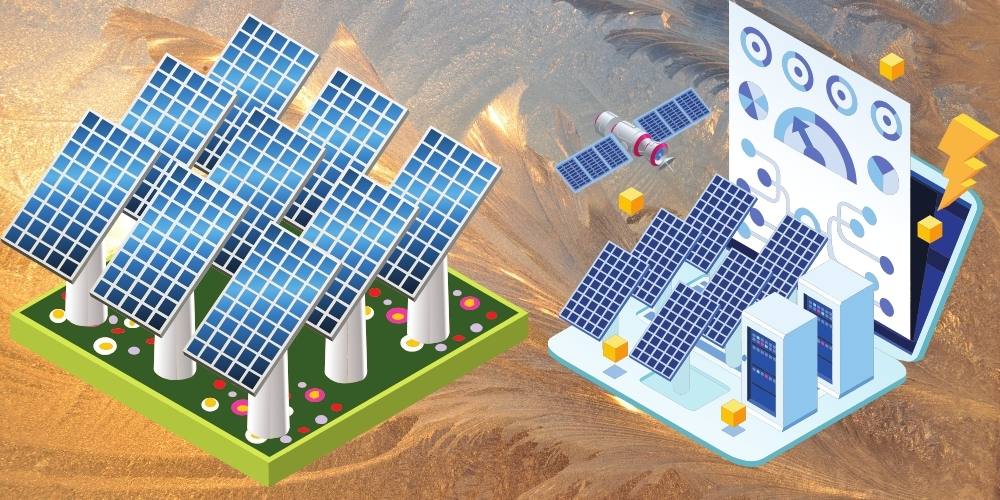
2. Reliable Off-Grid Power Solutions
Why Power Backup is Crucial
In a blackout, everything from communication and food storage to lighting and warmth becomes a challenge. Power backup ensures you stay connected, safe, and functional—even when the grid goes down unexpectedly.
Best Backup Options
- Portable Solar Generators: These eco-friendly units harness the sun’s energy to power lights, charge devices, and run small appliances. They’re quiet, easy to set up, and a great long-term investment for clean, off-grid power.
- Gas Generators: Gas-powered generators provide instant electricity and can run critical appliances like fridges or heaters. However, they need fuel, proper ventilation, and routine maintenance, making them suitable for short-term emergency use.
- Power Banks: Power banks are essential for charging phones, flashlights, or radios during a blackout. Keep several high-capacity banks fully charged and stored safely, so you’re always prepared to power up small electronics.
- Hand-Crank Chargers: These manual devices generate power through motion. While not ideal for large gadgets, they work great for radios and emergency flashlights—especially when solar or fuel options aren’t available.
Solar Power Systems
Installing a solar power system with panels, an inverter, and battery storage is a smart, scalable solution. You can run LED lights, charge electronics, and even operate small kitchen tools during extended outages.
Table: Off-Grid Power Comparison
| Power Type | Pros | Cons |
| Solar Generator | Renewable, silent | Needs sunlight, expensive |
| Gas Generator | Powerful, immediate | Noisy, needs fuel |
| Power Bank | Lightweight, simple | Limited capacity |
| Hand-Crank | Never runs out | Manual effort required |
Reliable power ensures your food stays fresh, phones stay on, and the dark doesn’t feel so scary.
BuySmart Emergency Power Backup

The Edison Generator bundle is a comprehensive guide to building a thermal energy generator. Priced at $39, it includes detailed instructions, diagrams, and a parts list, making it beginner-friendly and accessible. It’s designed for individuals seeking a cost-effective backup power source or a hands-on learning experience in alternative energy. While it requires effort and basic DIY skills, many users complete their generators in just a weekend.

3. Long-Lasting Food Supplies
Why Shelf-Stable Food Matters
During a power outage, your refrigerator and freezer become useless within hours. Without electricity, fresh produce and meat spoil quickly, so having nutrient-dense, non-perishable food ensures your family stays nourished and energized.
Top Foods to Store
- Canned Meats & Beans: Packed with protein and essential nutrients, canned meats and beans are filling, easy to prepare, and have a long shelf life. They’re a reliable source of energy when other food options become limited.
- Freeze-Dried Meals: These lightweight, vacuum-sealed meals only need hot water to prepare. They retain flavor and nutrition for years, making them perfect for emergency kits or long-term storage without taking up much space.
- Grains & Pasta: Dried grains like rice, oats, and pasta are staples in survival planning. They’re easy to cook, extremely filling, and versatile enough for many simple and satisfying meals, especially when resources are scarce.
- Nut Butters & Granola Bars: Nut butters are calorie-dense and protein-rich, while granola bars offer fast energy and portability. Both are excellent for quick meals or snacks when cooking isn’t an option or you’re on the move.
Food Storage Tips
- Cool, Dry, Dark Space: Store emergency food in areas that are cool, dry, and shielded from sunlight—like a basement or interior pantry. This helps prevent spoilage and extends the life of your food supplies significantly.
- Rotate Stock: Use the “first in, first out” method. Regularly check expiration dates and consume the oldest items first. Replacing them ensures your emergency stash is always fresh and ready when needed.
- Use Oxygen Absorbers: Adding oxygen absorbers to containers of rice, beans, or flour helps prevent spoilage and insect infestation. These inexpensive packets significantly extend the shelf life of your dry bulk foods.
Learn more about Emergency Food Storage…
Cooking Without Power
- Portable Gas Stoves: These compact stoves use propane or butane to heat water or cook food. Easy to store and operate, they’re a dependable option for hot meals when the power is out.
- Butane Burners: Small and efficient, butane burners heat up quickly and are ideal for boiling water or preparing simple meals. They’re great for indoor use, but always ensure proper ventilation for safety.
- Solar Ovens: Using only sunlight, solar ovens can cook a variety of meals with no fuel needed. They’re eco-friendly, reusable, and an excellent off-grid solution—especially useful during long-term power failures.
BuySmart Food Stockpile Guide

The Stockpile Savior is a must-read for anyone serious about being prepared for emergencies. This book provides a step-by-step guide on how to create a survival stockpile in just 10 days. It covers everything from essential food and water to security measures, ensuring that you’re prepared for the first 100 days of any disaster. The book is easy to follow, making it ideal for beginners, while its practical advice is also valuable for seasoned survivalists.

4. Light Sources That Don’t Rely on Electricity
Why Light Matters
Complete darkness during a blackout is not just inconvenient—it’s unsafe. You risk trips, falls, and injuries while moving around. Proper lighting provides safety, comfort, and peace of mind during nighttime grid failures.
Best Light Options
- LED Lanterns: LED lanterns provide bright, wide-area illumination and consume minimal battery power. Most models run for dozens of hours on a single set of batteries, making them ideal for overnight or extended outages.
- Solar Lamps: These eco-friendly lamps charge during the day and light up your space at night. With no need for batteries or fuel, they’re perfect for long-term blackouts and can even be used outdoors.
- Battery-Powered Headlamps: Headlamps are great for hands-free lighting, especially when you need to cook, work, or move around in the dark. Lightweight and efficient, they provide focused light right where you’re looking.
- Candles: Candles are a classic backup light source. They don’t rely on batteries or solar power, but always use them cautiously—keep away from flammable items and never leave them burning unattended.
Table: Emergency Light Options
| Light Source | Duration | Special Features |
| LED Lantern | 20+ hrs | Bright, safe |
| Solar Lamp | 8+ hrs | Recharges daily |
| Headlamp | 15 hrs | Hands-free |
| Candle | 4 hrs | Low cost |
BuySmart Emergency Power Backup
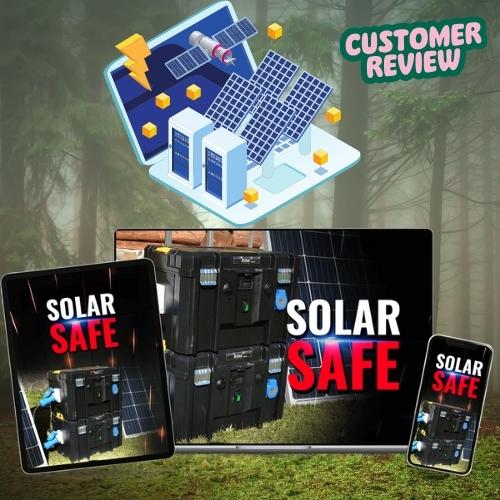
The Solar Safe Guide offers an easy and affordable way for homeowners and DIY enthusiasts to build their own solar power system. With clear instructions and helpful diagrams, the guide walks you through the entire process of creating a solar generator to reduce electricity bills. Starting at just $204, the system provides significant savings—up to 68%—on energy costs. The product is beginner-friendly, yet effective, ensuring that anyone can follow along, even with no prior experience.

5. Emergency Communication Tools
Why Staying Informed is Vital
When the grid goes down, phone networks and internet service can also be affected. Having backup communication tools ensures you stay informed and connected with family, neighbors, or rescue teams.
Must-Have Communication Tools
- NOAA Weather Radio: These radios give real-time weather alerts and emergency broadcasts. Most models are battery-operated or hand-crank powered, so they work even when there’s no electricity or cell signal available.
- Walkie-Talkies: Ideal for short-range communication between family or neighbors. They work independently of cellular networks, making them reliable for quick coordination and emergency planning within a limited range.
- CB Radios: Citizens Band (CB) radios can reach distances over 10 miles. Common among truckers and preppers, they’re effective for receiving updates and contacting others when all else fails.
- Emergency Whistles: A low-tech but life-saving tool. Use whistles to signal for help if trapped, lost, or in danger. Their sound carries farther than a voice and doesn’t rely on power.
Learn more about communication devices.
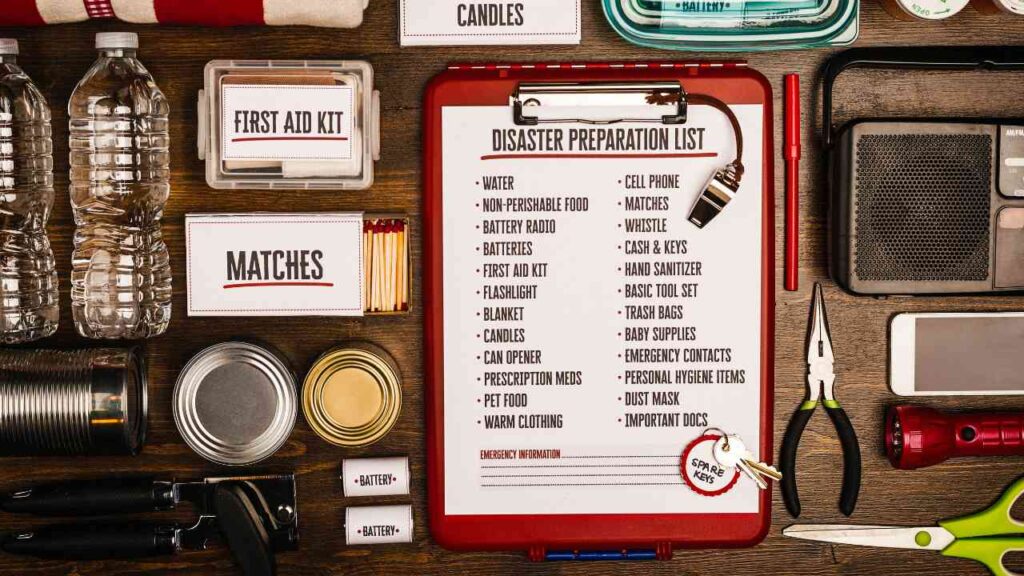
6. First Aid Kit and Medical Supplies
Why Medical Readiness is Critical
In a grid-down crisis, emergency services might be delayed or unreachable. Having essential medical supplies on hand allows you to treat minor injuries and manage health issues until professional help arrives.
Essentials to Include
- Bandages & Antiseptics: These are vital for cleaning and covering cuts or wounds to prevent infection. Include adhesive bandages, sterile gauze, medical tape, hydrogen peroxide, and antibiotic ointment in your kit for basic wound care.
- Pain Relievers & Allergy Meds: Stock over-the-counter medications like ibuprofen, acetaminophen, and antihistamines. These can help manage pain, fever, swelling, or allergic reactions when a pharmacy isn’t accessible during an outage.
- Prescription Meds (30-day supply): Keep a month’s supply of essential medications like insulin, heart meds, or asthma inhalers. Rotate regularly and consult your doctor about emergency refills to avoid running out in a crisis.
- Thermometer, Gloves, Tweezers: These tools help monitor illness and treat injuries. Use disposable gloves to reduce infection risk, tweezers for removing debris or splinters, and a digital thermometer to detect fever early.
Table: Basic First Aid Checklist
| Item | Purpose |
| Band-Aids | Small cuts |
| Gauze & Tape | Larger wounds |
| Alcohol Wipes | Disinfect |
| Ibuprofen | Pain/fever relief |
| EpiPen | Allergic reactions |
BuySmart Emergency Life Saving Book

The Survival MD book is an invaluable resource for anyone serious about emergency medical preparedness. It provides clear, actionable advice on how to handle medical emergencies when access to healthcare is limited. Whether you’re dealing with chronic health conditions, treating injuries, or managing medical crises, this book offers real-world solutions. Authored by Dr. Radu Scurtu, a medical professional with years of experience, the book is packed with expert insights.
Final Thoughts
Preparing for grid failure is not about fear — it’s about foresight. In uncertain times, a well-stocked home, working light sources, clean water, reliable communication tools, and medical readiness offer more than survival — they bring confidence. Every item you gather today is a shield for tomorrow.
Whether it’s a thunderstorm, a cyberattack, or an unexpected emergency, being ready keeps your family safe, calm, and strong. Remember, preparedness is not a one-time act but a lifestyle of resilience. You don’t need to do it all at once. Take the first step now — and take back your peace of mind. 💡🛠️
Be prepared, not scared — because your future deserves it.
FAQs (Frequently Asked Ques)
Grid failure means a large-scale power outage. It can disrupt water, food, communication, and heating—making preparation essential for safety.
Store at least 3 days’ worth per person. Aim for 1 gallon of water and 2,000 calories per day.
Solar generators are quiet and renewable but slower to charge. Gas generators offer instant power but require fuel and ventilation.
Use portable gas stoves, butane burners, or solar ovens. These work without electricity and can safely prepare hot meals.
Start with clean water, shelf-stable food, and a flashlight. These basics cover survival while you build your full emergency kit.
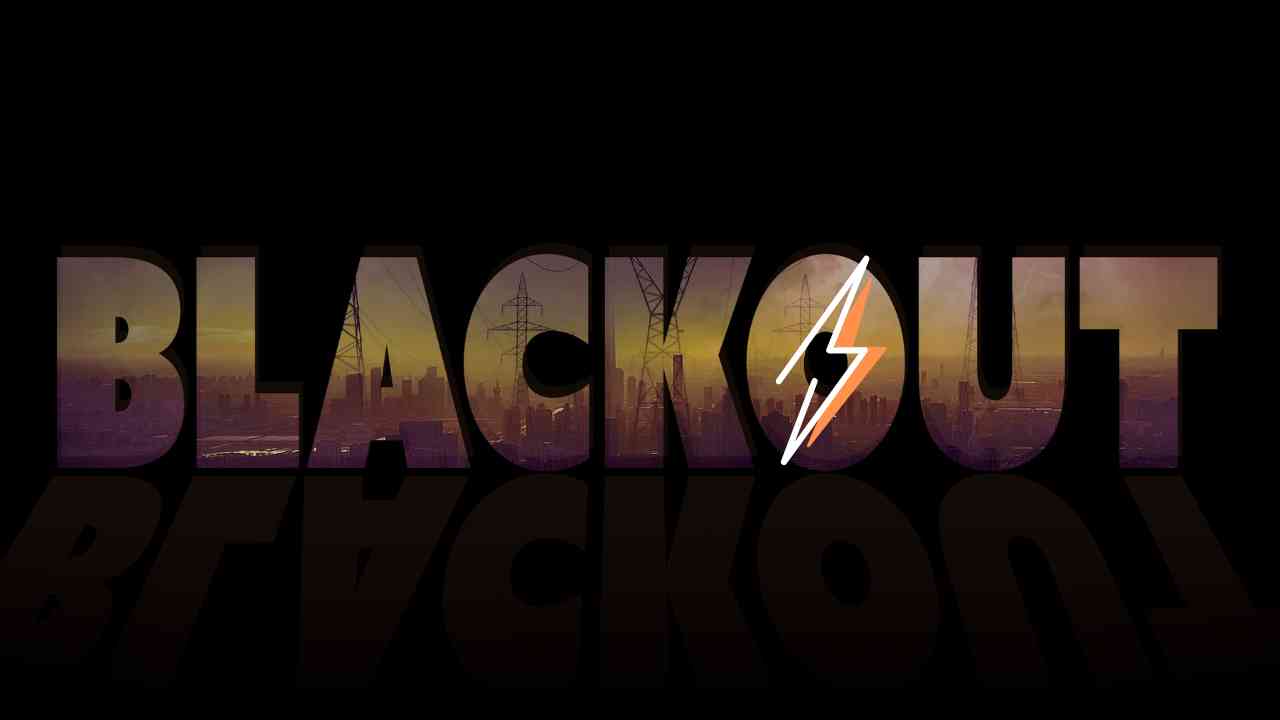
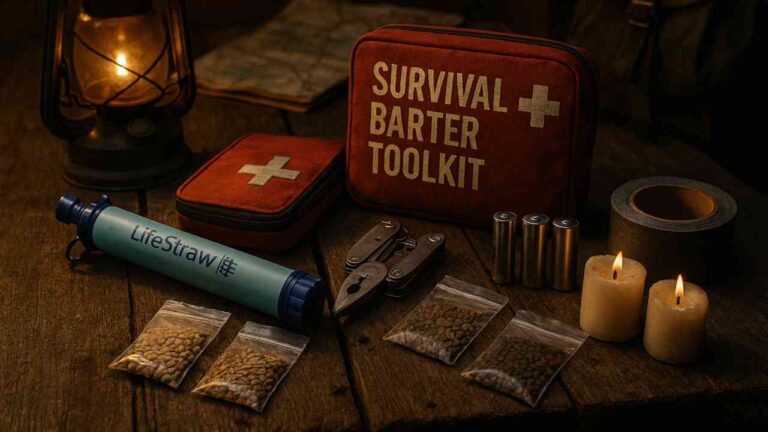
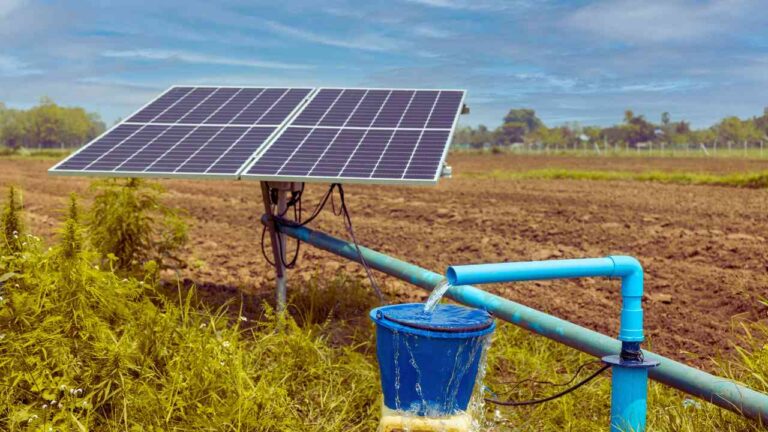
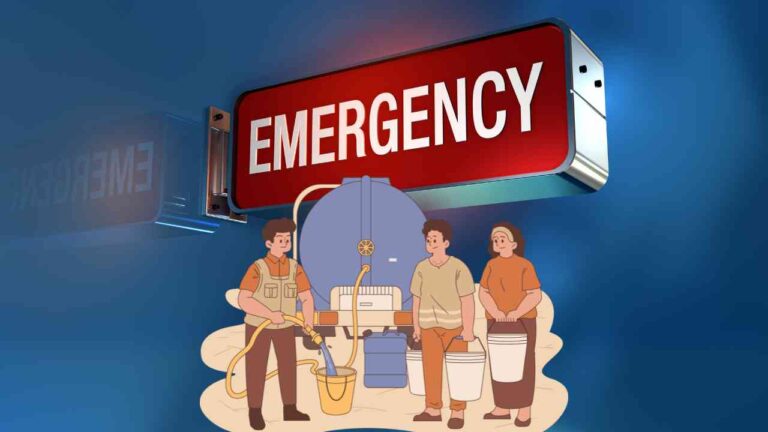



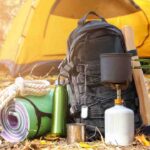
[…] only protecting yourself but also creating opportunities to help neighbors and build trust during high-stress situations when resources are […]